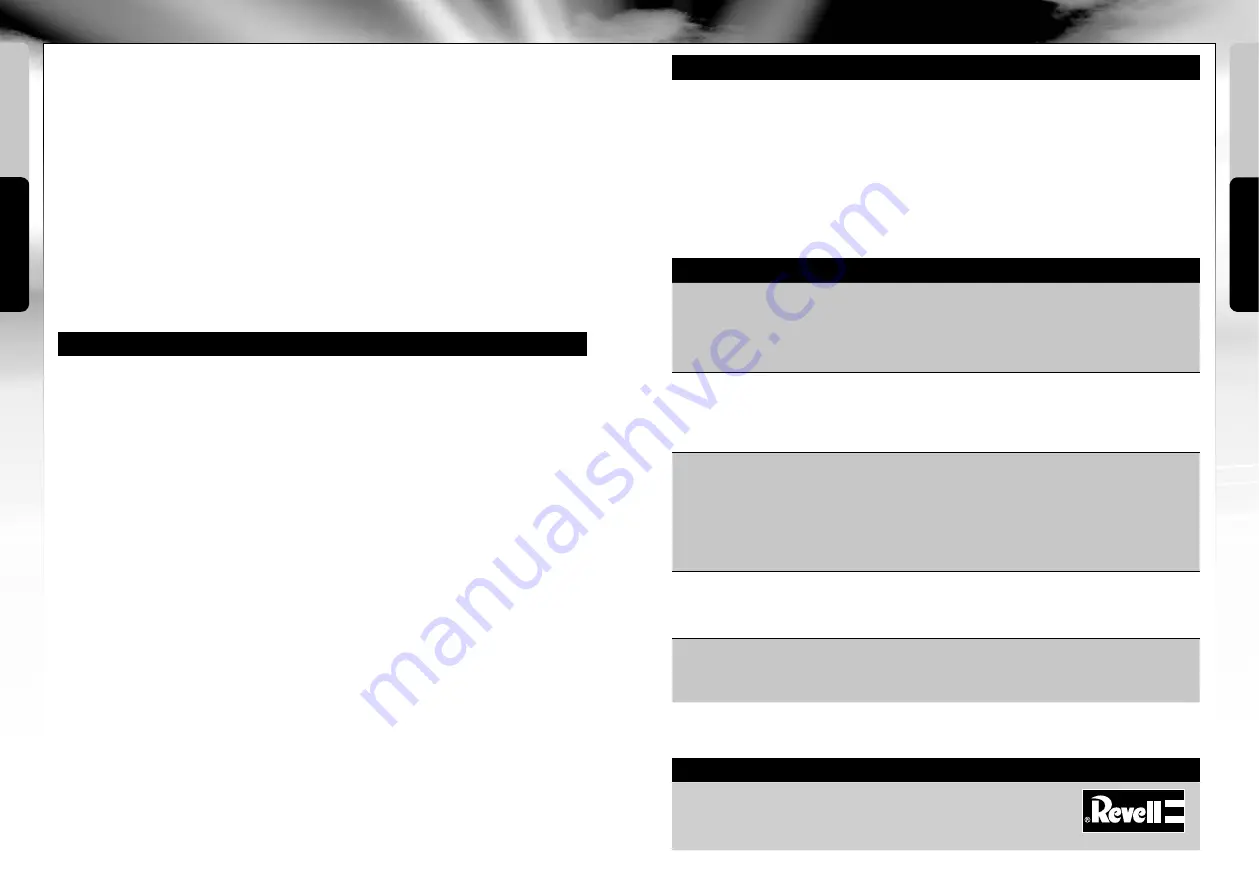
SUITABLE FLYING ENVIRONMENT:
The location in which the helicopter is flown
should fulfil the following criteria:
• It should be an indoor location without
any wind. Insofar as possible, there should
be no air conditioning systems, heaters,
etc. that can cause air currents.
• The room should be at least 10 metres long,
six metres wide and three metres high.
• No disruptive objects, such as fans, lamps,
etc. should be present in the room.
• When initialising take-off, make absolutely
sure that all persons and animals –
including the pilot – are at least 1-2 metres
removed from the aircraft before flight
begins.
• Always watch the aircraft, so that it
does not fly into the pilot, other people
or animals and injure them.
8A
First pull off the upper and lower control bars (arrows) from the flybar for the rotor.
8B
Now rotate the mixing arm (arrow) 90° and pull it off towards the front.
8C
Then unscrew the two screws in anticlockwise motion.
8D
Now the rotor blade can be pulled off and replaced. Proceed in reverse order
for assembly.
8E Attention:
The pin of the follower (arrow) must protrude into the slot in the
lower control bar.
If the helicopter‘s rotor blades have been damaged, they must be replaced.
Proceed as follows:
English
English
INSTRUCTIONS FOR SAFE FLYING
GENERAL FLYING TIPS:
• Always place the helicopter on a level
surface. An inclined surface can, under
certain circumstances, negatively effect
the helicopter during take-off.
• Always operate the controls slowly and
with a gentle touch.
• Always maintain visual contact with the
helicopter and do not look at the remote
control!
• Move the thrust controller somewhat
down again once the helicopter has lifted
off from the ground. Maintain flying
altitude by adjusting the thrust controller.
• If the helicopter lowers, move the thrust
control slightly upward again.
• If the helicopter climbs, move the thrust
controller down slightly.
• To fly along a curve, tapping the
directional controller very slightly in the
respective direction often suffices.
There is a general tendency during
preliminary attempts at flight to operate
the helicopter‘s controls too aggressi-
vely. Always operate the controls slowly
and carefully. Never fast and fitfully.
• Beginners should first master trimming
before attempting to master the thrust
controller. It is not necessary for the
helicopter to fly straight at first. It is far
more important to maintain a constant
height of approximately one metre
above the ground by repeatedly tapping
the thrust controller. Only then should
the pilot practise steering the helicopter
left and right.
BATTERY STATUS:
• The battery is empty if the helicopter begins to lose thrust. Land in order to
avoid crashing.
8 CHANGING THE PROPELLERS
TROUBLESHOOTING
Problem: The rotor does not move.
Cause:
1. The battery has not been pushed in all the way.
2. The battery is too weak or depleted.
Remedy:
1. Push the battery in until it clicks in place.
2. Charge the battery.
Problem: The helicopter stops and descends during flight for no apparent
reason.
Cause:
• The battery is too weak.
Remedy:
• Charge the battery.
Problem: It isn‘t possible to control the helicopter using the remote control.
Cause:
1. The ON/OFF switch is in the "OFF" position.
2. The batteries were not inserted correctly.
3. The batteries do not have enough power.
Remedy:
1. Set the ON/OFF switch to the "ON" position.
2. Check whether the batteries are inserted correctly.
3. Insert new batteries.
Problem: The helicopter rolls over when started.
Cause:
• The control bars of the rotor are detached.
Remedy:
• Attach the control bars as shown in the manual.
Problem: The helicopter „wobbles“ during flight.
Cause:
• A control bar is missing.
Remedy:
• Check all control bars and replace as necessary.
Additional tips and tricks can be found online at
www.revell-control.de.
7C
Fly forward by moving the controller for forward/backward and sideways
2I
flight carefully forward.
7D
Fly backward by moving the controller for forward/backward and sideways
2I
flight
carefully backward.
7E
Fly to the left by moving the controller for forward/backward and sideways
2I
flight
carefully to the left.
7F
Fly to the right by moving the controller for forward/backward and sideways
2I
flight carefully to the right.
7G
Turn helicopter around to the left by moving the controller for thrust and rotation
2C
to the left.
7H
Turn helicopter around to the right by moving the controller for thrust and rotation
2C
to the right.
Turbo function
For more speed, press the turbo button on the top left of the remote
control. Please do not use this function until you have gained sufficient experience
in the standard setting, because the model reaction becomes more sensitive, which
makes a fine touch necessary when controlling it. Pressing the button again switches
the helicopter back to normal flying mode.
16
17
www.revell-control.de
SERVICE NOTES
Go to www.revell-control.de for ordering information
and tips on replacing spare parts, plus other useful
information on all Revell Control models.
Summary of Contents for 23911
Page 22: ...42 43 Notes Notes...








































